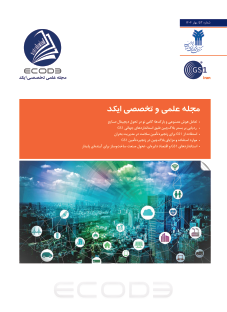![]() ِDigital Economy and Gs1 Solutions
ِDigital Economy and Gs1 Solutions
![]() Order To Cash By Gs1 EDI
Order To Cash By Gs1 EDI
|
ِDigital Economy and Gs1 Solutions |
ماهنامه شماره4(آذرماه 1394)
1. Introduction
The societies are becoming increasingly dependent on the Internet and digital technology to exist. Nowadays Internet links millions of people through computers and mobile devices. Electronic commerce has become a primary mechanism for firms to conduct business from both an operational and retail perspective.
The digital economy is the result of the transformational effects of general purpose technologies in the fields of information and communication. It has impacted all the sectors of the economy and social activities, for instance: retail, logistics, healthcare, financial services, manufacturing, education, media and so on. It has implications much beyond the Information and Communication Technology (ICT) sector. In addition, the internet is empowering people in a new and different way to create and share their ideas, giving rise to new content, entrepreneurs and markets.
The digital economy has built on previous technological innovations such as personal computers and telecommunications via fiber, cable or wireless and now it has been improved by the internet of things (IOT). IoT refers to any smart interconnected devices (RFID, sensors, etc.) adopted by businesses to obtain more visibility of the identification, location, and condition of products, assets, transactions, or even people. The ultimate goal is to be able to trace pedigree and to drive more effective, timely business decisions or to improve customer interactions.
GS1 recommends that the states facilitate widespread adoption of global supply chain, business process and communication standards, as well as automatic identification and data capture technologies in their industry. To adopting GS1 solutions, the government or any other institutions, must support the creation of the means to network this information through a server. These activities represent the critical first steps for realizing an innovative vision for advancement of the Internet of Things, establishing the platform for creation of the productivity-enhancing digital applications of the future.
2. The Digital Economy Sectors and ICT
All sectors of the economy have adopted ICT to enhance productivity and reduce costs. This adoption of ICT is illustrated by the spread of broadband connectivity in businesses, which in almost all countries of the Organization for Economic Co-operation and Development (OECD) is universal for large enterprises and reaches 90% or more even in smaller businesses.
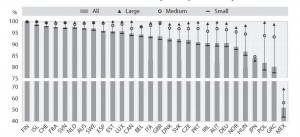 Figure 1. Enterprises with broadband connection, by employment size
Figure 1. Enterprises with broadband connection, by employment size
The widespread adoption of ICT, combined with the rapid decline in price and increase in performance of these technologies, has contributed to the development of new activities in both the private and public sector.
Together, these technologies have expanded market reach and lowered costs, and have enabled the development of new products and services. These technologies have also changed the ways in which such products and services are produced and delivered. They also support activity by individuals and consumers, and have led to the creation of new payment mechanisms including new forms of digital currencies. The advent of the Internet brought major changes first to the entertainment, news, advertising, and retail industries. In those industries, the first major digital players initially started from traditional business models, adapting them to better end-user equipment and more extensive interconnection through the Internet.
As technology has advanced and costs of ICT have continued to fall, ICT has proven to be general-purpose technology that has become embedded in and central to the business models of firms operating across the economy.
Businesses across all sectors are now able to design and build their operating models around technological capabilities, in order to improve flexibility and efficiency and extend their reach into global markets. Businesses across all sectors have changed the way their business is conducted by taking advantage of advances in communications and data processing capacity to lower transaction costs and extend their reach into global markets.
Sectors, due to the spread of ICT, can be divided as follow:
Retail: The digital economy has enabled retailers to allow customers to place online orders and has made it easier for retailers to gather and analyze data of customers, to provide personalized service and advertising. It has also enabled retailers to manage logistics and supply stores with products, which has had a significant, positive impact on productivity.
Transport and Logistics: The logistics sector has been transformed by digital economy, which enables the tracking of both vehicles and cargo across continents, the provision of information to customers and facilitates the development of new operational processes such as Just In Time delivery in the manufacturing sector.
Healthcare: The digital economy has made a revolution in the healthcare sector, from enabling remote diagnosis to enhancing system efficiencies and patient experience through electronic health records.
Financial Services: Banks, insurance providers and other companies, including non-traditional payment service providers, increasingly enable customers to manage their finances, conduct transactions and access new products online. Better use of data also allows growth in customer insights and associated products, such as personalized spending analysis, which can be used to generate advertising revenue. The digital economy has also made it easier to track and manage investment portfolios and has enabled specialist businesses such as high-frequency trading.
Manufacturing and Agriculture: The digital economy has enhanced design and development, as well as the ability to monitor production processes in factories and control robots, which has enabled greater precision in design and development and ongoing product refinement. The products being produced are also increasingly knowledge-intensive. In the automobile industry, for example, it is estimated that 90% of new features in cars have a significant software component. On farms, systems can monitor crops and animals, and soil/environmental quality. Increasingly, routine processes and agricultural equipment can be managed through automated systems.
Education: As the digital economy spreads, universities, tutor services and other education service providers are able to provide courses remotely without the need for face to face interaction through technologies such as video conferencing and streaming and online collaboration portals, which enables them to tap into global demand and leverage brands in a way not previously possible.
Broadcasting and Media: The digital economy has dramatically changed the broadcasting and media industry, with increasing broadband access for delivery of content for traditional media players, while also enabling the participation in the news media of non-traditional news sources, and expanding user participation in media through user-generated content and social networking. The digital economy has also enhanced the ability of companies to collect and use information about the viewing habits and preferences of customers, to enable them to better target programming.
As digital technology is adopted across the economy, segmenting the digital economy is increasingly difficult. In other words, because the digital economy is increasingly becoming the economy itself, it would be difficult, if not impossible, to fence the digital economy from the rest of the economy.
3. Key Features of the Digital Economy
There are a number of features that are increasingly prominent in the digital economy. While these features may not all be present at the same time in any particular business, they increasingly characterize the modern economy. They include:
Mobility, with respect to (i) the intangibles on which the digital economy relies heavily, (ii) users, and (iii) business functions as a consequence of the decreased need for local personnel to perform certain functions as well as the flexibility in many cases to choose the location of servers and other resources.
Reliance on data, including in particular the use of so-called “big data” or “Master data”. Data as a source of value is a key feature of the digital economy. Data are collected from several market players and activities. The increasing capacity to collect, store and treat massive flows of data has led to the concept of “big data” that could generate value either in private (marketing) or public (government) activities.
Network effects, understood with reference to user participation, integration and synergies.
Network effects are penetrating in the digital economy. They have allowed private value creation especially through so-called multi-sided business models. In those models, several groups of persons interact through a platform, resulting in positive or negative externalities. If many examples could be quoted of multi-sided business models (e.g. payment card system, operating system, media industry), the most famous one is that of compulsory advertising considered as a negative externality (intrusive, unattractive) which is compensated by the low-cost or even free offer of a service (e.g. search engines).
4. The Digital Economy and the Internet of Things
At the sapphire now® conference in 2015, nearly 100 organizations shared their opinions about the value of digital economy and the Internet of Things (IoT) and answered the following question:
“How can embracing the digital economy and the Internet of Things (IoT) help the business succeed?” Their anticipations of the benefits and their relations are shown below.
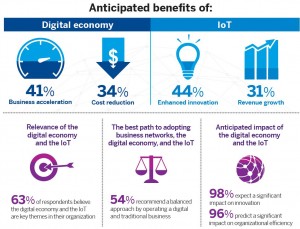 Figure 2: Digital Economy and IoT
Figure 2: Digital Economy and IoT
5. Canada’s GS1 Solution for Digital Economy: Internet of Things
The Internet of Things is the solution for the transformation of Canada’s digital economy. The Internet of Things has come to describe a number of technologies and research disciplines that enable the Internet to reach out into the real world of communicating objects. The internet architecture of the future is set to revolutionize person-to-thing and thing-to-thing interaction through technologies like Radio Frequency Identification (RFID), short-range wireless communications and real-time localization and sensor networks, all of which are bringing the Internet of Things into commercial use.
GS1 Canada recommends that the government facilitate widespread adoption of global supply chain, business process and communication standards, as well as automatic identification and data capture technologies across Canadian industry. Further, GS1 Canada urges the government to support the creation of the means to network this information through a domestic server. These measures represent the critical first steps for realizing an innovative vision for advancement of the Internet of Things in Canada, establishing the platform for creation of the productivity-enhancing digital applications of the future.
The concept of the Internet of Things is truly visionary. It covers fundamentally different modes of communication: thing-to-person communication and thing-to-thing communications which could potentially involve 50-70 billion machines, of which only 1% are connected today. The scope of the Internet of Things is limited only by our imagination and our ability to build and use digital technology systems.
Consumer demand for product information is increasing. Consumers want information about health and wellness (e.g. allergens), product safety (e.g. toxicity, authenticity) and sustainability (e.g. packaging sustainability attributes), and they want it instantly. Concisely, consumers will soon expect to be able, at or before the point of sale, to know where the product comes from, what it is made of and what has happened to it since its production. The Internet of Things will allow this type of information exchange.
5-1. The Digital Evolution in Future
Before discussing the technological and system details of the digital evolution, it is important to first provide a picture of what a digitally enabled future looks like for Canadians.
In the Supply Chain: Warehouses will be fully automated, with items being checked in and out, orders passing to suppliers automatically, and information about products being accessed via wireless networks.
In the Grocery Store: Consumers will scan products with their mobile phones to access data about the journey of a product through the supply chain from manufacturer through the store shelf, to ascertain sustainability details about the product such as carbon footprint and fair trade, to identify allergen and dietary information, and to pay for the product.
At the Hospital: One area where the technology that enables the Internet of Things may have immediate and considerable impact is healthcare. The ability to provide continuity of care, continuous patient monitoring, shared yet secure medical records, valid and accurate medical dosages, medical equipment tracking and improved information display and communication, are some of the opportunities provided by the proposed infrastructure, ultimately reducing costs while increasing the reliability and effectiveness of healthcare delivery.
At the Restaurant: Patrons will scan the menu with their mobile phones or blackberries to view the nutritional content of the recipes. Restaurants would receive automatic updates from their vendors and distributors about the nutritional content of the products they use, never having to worry about whether their menus are accurate.
At Home: The refrigerator of the future will monitor the food inside of it and notify owners when the content is approaching its best-before date; the stove will recognize the product in the pot and cook it at the right temperature, timing it to be finished at the same time as the roast in the oven. Smart metering systems will provide household energy consumption information to consumers, in real time, about how much electricity they are using, allowing them to adjust usage accordingly.
5-2. The Internet of Things: A Digital Transformation
The interconnection of physical objects is expected to amplify the profound effects that large-scale networked communications are having on our society, gradually resulting in a genuine paradigm shift. Examples of this development include connected cars helping reduce traffic congestion, enabling the efficient movement of goods and people across borders, and increasing the productive use of natural resources. From an environmental point of view, connected trees could fight deforestation by tracking the level of carbon in rainforests. The overall impact on global supply chains and on Canadian productivity is yet to be fully understood and quantified; however, the opportunities for transformational innovation are clear, real and imminent.
5-2-1. Understanding the Technology
In order for this type of digital transformation to occur, Canada must first ensure the building blocks and system linkages are in place. At the most fundamental level, the norms require that RFID tags and associated sensors can operate, can be seen and can be queried anywhere in the world, providing visibility throughout the global supply chain. RFID technology is globally recognized as a technology that has the potential to transform and to dramatically improve the way business is conducted. The key element in RFID technology is the transponder (or tag) which is an electronic component consisting of a chip and an antenna. The chip – which can measure just a few millimeters – can wirelessly store, receive and transmit information on the attributes of the product to which it has been applied. Experts in the field claim that in the future these chips will replace the bar codes in use today due to their advantages: RFID tags do not have to be touched to be read, as in the case of magnetic strips, or even be in a direct line of sight, as in the case of bar codes, and can hold significantly more information than bar codes.
Through various technological breakthroughs, RFID is now becoming more affordable; in the future, most everyday objects (such as transportation passes, clothes, mobile telephones, and cars) could be fitted with RFID tags. RFID offers significant business efficiencies (e.g. the ability to measure inventory wirelessly) driven mainly due to the opportunity to identify individual products uniquely, thereby enabling organizations to access more detailed information specific to each particular item, rather than simply generic properties or specifications defined at the level of the product class.
EPC global Inc., the fully owned subsidiary of GS1 tasked with developing industry-driven global standards for use of RFID in the supply chain, manages the standard called the Electronic Product Code (EPC). The EPC allows for globally unique identification of objects using RFID, combining, within an RFID tag, a serial number unique to a specific object with an identifier unique to a particular company. In this way, the EPC allows for the unique identification of every object with RFID, acting as the key to enabling these unique objects to interact through the Internet. The figure below graphically demonstrates the components of the Electronic Product Code.
Figure 3: EPC as a means of unique identification
It should be noted that RFID technology is not yet widespread across all industry sectors. The level of utilization of the technology can be explained by the fact that in itself, RFID is just a technology enabling efficient data capture. Business process improvements will be derived from improvements in the ability to access to data and improvements to the infrastructure to support the communication of data between companies and between objects.
Combining the EPC standard with RFID technology, and linking to communications network infrastructure, will enable accurate, cost-efficient visibility of product and location information in the supply chain. EPC global is leading global industry collaboration to define the set of supply chain, business process and communication standards to enable this capacity worldwide, including the networking standards – standards for data discovery – through an ONS; foundational architecture for lookup services that takes an EPC as input, and produces as output the address (URL) of a service designated by the company associated with the EPC in question. Simply put, the ONS is a router – a network switch – which can be used to convert, for example, a barcode to a URL to a company website. In slightly more technical terms it can be described as an automated networking service that points computers to services on the World Wide Web.
It is important to recognize how ONS works, as it is the fundamental component of the Internet of Things. As an example, when users want to locate information about a product, they would first consult ONS. ONS would then return a list of services available for the product in question; the application would then access the service(s) of interest. These services may include product data (allergens, nutrition, etc.), recall status, warranty information, and more.
Within EPC global, the most significant service is the Electronic Product Code Information Service (EPCIS). Despite its name, EPCIS is not a service offered by GS1, rather, it is a specification for a service that may be implemented by any solution provider. The goal of EPCIS is to enable disparate applications to leverage EPC data via EPC-related data sharing, both within and across enterprises.
 Figure 4: ONS Interaction with the Discovery Services Concept
Figure 4: ONS Interaction with the Discovery Services Concept
The ONS was originally architected by the EPC global community as an application of the Internet Domain Name Service (DNS). According to the current ONS specifications by EPC global, there is a single ONS root zone, onsepc.com, managed by US organization Verisign Inc. Based on the Internet DNS protocol and infrastructure, the ONS allows storing and looking up information associated with an object carrying an RFID tag, as an application of the existing Internet architecture.
5-2-2. System Transformation to the Internet of Things
As moving toward the Internet of Things, governments must recognize the importance of linking supply chains from end to end and facilitating the Internet architecture that will enable regional and cross-sectoral access to interoperable network infrastructure in a way that enables the flow of information using state of the art technology, while protecting privacy and providing security for commercially valuable information. This infrastructure is vital to ensuring that small and medium-sized enterprises (SMEs) can compete in the global economy.
The Internet of Things will permit the networking of billions of machines that will be able to communicate and interact with one another via wireless technologies using logical and physical addressing protocols; it will enable, through the use of electronic identification systems and wireless mobile devices, digital entities and physical objects to be identified directly and conclusively so as to allow the data they contain to be identified, captured, exchanged and continuously processed.
The creation of an Internet of Things, which links together objects through unique, standardized product coding, technology systems and complex, synergistic databases, requires government intervention. It is a fundamentally new concept rather than an add-on to the existing digital systems and its creation is taking place in an environment affected by a number of challenges. First, the number of connected devices is increasing, while their size is reduced below the threshold of visibility to the human eye. In addition, objects are ever more wirelessly connected, enabling the geo-localization of individuals. Privacy considerations will be fundamental to developing consumer trust in the Internet of Things. Finally, the Internet of Things will come to maturity in an environment already crowded with proprietary applications that are not designed to be interoperable.
GS1 Canada recommends that the government undertake measurable steps to advance the Internet of Things, including building the capacity to link real world objects to virtual counterparts. Early adopters in Canada are already introducing Canadians to innovative business processes that signal the coming of the Internet of Things. For example, self-checkout stations at local grocery stores, Canadian Tire or Wal-Mart present consumers with the opportunity to manage the checkout process with the latest product identification technologies; familiarizing a new generation of consumers with the linkage between tangible products and the databases that house the virtual information about these products. For such systems to work, each product must be uniquely identifiable through either a bar code or an RFID chip, and must be able to “talk” to the database which contains the unique information about it. The ability of objects to communicate such data, and the ability of Internet infrastructure to support such transactions, will lead to the development of new industries and the commercialization of value-added applications that will dramatically impact both industry productivity and the consumer experience. The applications are almost endless; reading the bar code or RFID chip in a car tire, children’s toy or pharmaceutical product and accessing product information about the exact, individual product through the Internet will provide Canadians with information relating to consumer safety, ingredients, allergen content, recall status, coupons, promotional material, recipes, and numbers in inventory.
As we evolve from an Internet characterized as a network of computers and servers, to an Internet of Things (or “goods”), there will be three main change requirements:
1. Systems Development: the development of the operating characteristics, intelligence and sophistication of the physical objects (e.g. through readers, tags and sensors);
2. Management of Internet Resources: clear definitions of user-based models and data definition exchange standards, and creation of a federated network infrastructure, based on an openly defined and implemented network architecture that is able to operate locally and be linked globally;
3. Governance of the Internet of Things: this technological evolution will require new Internet governance systems to cover new functionality and, fundamentally, protect the privacy of Canadians.
Each of these three areas is discussed below.
1. Systems Development
Globally, the architecture of the Internet of Things is developing rapidly with the rise of mobile Internet usages and the diversification of connected objects. This represents substantial opportunities for Canada’s vibrant R&D community to showcase their skills in technological innovation, to drive development of applications to stimulate growth of the Internet of Things. We need only look to the technology triangle in south-western Ontario to recognize such skills not only exist in Canada, but have been cultivated in a way that position Canada to become a global leader in this area.
Given that the next phase of the EPC global network development will have to allow for integration of product information provided by a large number of organizations horizontally across the supply chain and vertically across other industries and countries, there is also a need for increasingly widespread adoption of product and location identification standards, and establishment of a Canadian ONS server to route data inquiries.
2. Management of Internet Resources
The Domain Name System, managed in the United States, is one of the most visible centralized infrastructures supporting the Internet. It was created in 1983 for practical reasons – Internet users were finding it difficult to remember IP addresses. Allowing for easy to remember “domain” names (e.g. www.coca-cola.com) increased the usability of the Internet. The Internet is based on the centralized architecture of the DNS routing system, routing users to IP addresses based on domain names. As previously noted, the ONS was created by the EPC global community as an application of the DNS, enabling the storing and looking up of information associated with an object carrying a RFID tag. As the Internet of Things evolves, the centralized, “single-root” architecture of the ONS is increasingly a drawback for the development of new applications for the future Internet, with concentration of the ONS root governance in the hands of a single entity, highlighted at the French EU Presidency 2008 conference on “the Internet of the Future” as an obstacle hindering the deployment of a worldwide ONS. This position has led to recent work by countries such as France and Sweden to create domestic ONS root-servers that will enable a distributed ONS architecture.
The development of new applications and services that rely on geographically-located information systems, and their connections with RFID tags and mobile services, will make a domestic ONS root-server even more crucial to the development of the Internet economy in Canada. Information security, infrastructure stability and national sovereignty will be key considerations in the deployment of the Internet architecture of the future that will support the Internet of Things.
3. Governance of the Internet of Things
Technological advances will occur regardless of government intervention; however, simply leaving the development of the Internet of Things to the private sector, and possibly to other world regions, is not a desirable option in light of the significant societal changes that the Internet of Things will bring about. Many of these societal changes will need to be addressed by Canadian policy makers and public organizations to ensure that the use of new digital technologies and applications will stimulate economic growth, improve our overall well-being and protect Canadians’ privacy and commercial interests.
In particular, the governance of the Internet of Things, including data discovery services, must be designed and exercised in a coherent manner, aligning with all public policy activities related to Internet governance. The global scale of this emerging network also necessitates the development of an architecture framework that will allow for an open governance model. Given the emerging importance of the ONS as a critical component of this Internet architecture of the future, it is becoming urgent for Canada to develop alternative solutions to the current centralized model. GS1 Canada recommends that Canada follow the approach taken by other jurisdictions around the world such as China, France and Sweden, which have pursued a federated ONS governance model based on domestically housed ONS root servers that can effectively facilitate the use of the global network, while addressing national privacy, security and sovereignty issues.
One of the main governance issues will undoubtedly be related to the privacy and protection of personal data. Social acceptance of the Internet of Things will be conditional on effective governance rules dealing with the privacy and protection of personal data; the development of the Internet of Things therefore will be dependent on how this issue is dealt with from a public policy perspective. A prerequisite for trust and acceptance of these systems is that appropriate data protection measures are put in place against possible misuse and other personal data related risks. Unfortunately, information security is often considered after the design phase of new technologies and systems, making the integration of safeguards to protect such information difficult and expensive in later stages. It is therefore critical that the components supporting the Internet of Thing are designed from their inception with a security and privacy-by-design mindset that comprehensively includes user requirements.
5-3. The Need for a Domestic Solution
The global development of the Internet of Things and related applications will have a major impact on the daily lives of Canadians and their habits in years ahead, leading to a broad range of economic and social changes. Indicators that this evolution is already underway, including the activities ongoing in other jurisdictions to stimulate development, denote the critical importance of the Government of Canada taking a forward-thinking, proactive approach when creating its Digital Economy Strategy, to not only ensure that Canada is prepared to address this evolution, but that it is positioned to lead. The Digital Economy Strategy must therefore include a strategy to move forward with the creation of a made-in-Canada architecture for the Internet of Things, and policy positions that support this technological innovation.
There are a number of important policy considerations. From a data security perspective we need to decide what information should be controlled and maintained within Canada’s borders. From an infrastructure perspective, we need to determine how companies and objects get registered and connected to this future network, and how this data is managed and shared. If Canada does not have domestic ONS architecture, Canadian businesses’ and citizens could have data with personal and commercial value put at risk, since data queries will be routed through other jurisdictions. From a legal perspective, Canada will need to make legislative adjustments regarding the management of information over the network. For example, the creation of a root ONS system requires putting data into a repository so it can be queried and then providing a path to find the data. Neither aspect – hosting the data in Canada nor having a path within Canada – is currently addressed in Canadian legislation.
By instituting a proactive approach, Canada will be positioned to take a leading role in shaping the evolution of the Internet of Things, reaping the associated benefits in terms of economic growth and individual well-being. Failing to do so would mean missing an important opportunity to influence an imminent, global resource and could place Canada in a position where it is forced to adopt technologies that have not been designed with its core values and societal requirements in mind, such as the protection of privacy and commercially valuable data. A made-in-Canada solution has the opportunity to build in safeguards for consumer privacy and data security for business, including opt-in and/or privacy by design.
5-4. Recommended Next Steps for the Government of Canada
The Internet of Things is not yet a tangible reality; it is a prospective vision of a number of technologies that, combined together, could dramatically modify the way Canadian’s society operates within the next 10 years. In order to position Canada as a leader in creating this next generation of digital innovation, and to drive economic value through the commercialization of related emerging industries, we recommend the federal government focus Canada’s energies on three major areas:
5-4-1. Facilitating industry adoption of global identification standards
The GS1 System of global standards is a common business language used by over one million organizations worldwide to standardize the identification of items, services, locations, logistic units, etc., and is used to simplify the exchange of related data with their business partners around the world. GS1 standards (such as bar codes) are used to connect physical and logical things to information or business messages related to them.
5-4-2. Facilitating industry adoption of automatic identification and data capture technologies
The Electronic Product Code is the GS1 standard for identifying objects at a unit level using RFID technology. The EPC enables every object in the world to be identified uniquely, with RFID being the key to enabling these unique objects to interact through the Internet. This is central to enabling the Internet of Things.
5-4-3. Supporting Canadian implementation of the Object Naming Service (ONS)
The core infrastructure currently being designed to underpin the Internet of Things are called Data Discovery Services, a suite of services that enables query-issuers to identify the location of EPC-related data and to request access to that data. The lynchpin of the data discovery process is the ONS. The ONS is the framework for retrieving information about objects from standards-based registries, through the Internet. With objects identified based on GS1 standards and connected to the network using EPC/RFID, ONS will enable discovery of information related to the registered objects.
5-4-4. Supporting Development of Product and Location Registries
Registries of standardized product and location information are fundamental to enabling queries issued through Data Discovery Services. The development of GS1 standards-based registries is essential to enabling the registration of products and locations by organizations, ensuring accurate, authentic data related to products and locations is accessed by users.
GS1 Canada is currently supporting Canadian industry in the adoption of a collaborative business model based on global supply chain, business process and communication standards and best practices for e-commerce that will ultimately prepare Canadian business for success in the digital economy. As a neutral, non-profit organization, we have a proven track record of working with governments, business, technology experts, industry associations and the public to help develop interoperability of technology solutions and drive change leadership in digital innovations. As well, one of GS1 Canada’s core roles is to work with industry to build communities to foster collaboration on key challenges and opportunities facing Canadian businesses, from manufacturers, to distributors, to retailers, supporting collective resolutions and outcomes. GS1 is well-positioned to support the government in the realization of its goals and objectives related to advancing a digital economy strategy for Canada.
Through this strategy, Canada should become a driving force behind the creation of the Internet of Things. The advancement of Canada’s digital economy must continue to be a government priority and must be broader than just Internet connectivity. We encourage the Government of Canada to establish a working group made up of organizations such as GS1, technology providers, business leaders, and systems experts to begin the dialogue immediately about how we can create a made-in-Canada architecture for the Internet of the future, consistent with the global movement toward sovereign ONS root servers, to enable domestic businesses and citizens to take full advantage of the emerging Internet of Things.
6. Conclusion
Today’s changing digital economy needs some solutions to open the ways for this great change. GS1 standards can help the governments to transform their economy by implementing GS1 solutions. Supply chain visibility, inventory accuracy, data sharing improvements and product traceability contribute to a more efficient, agile retail operation. Track and trace technologies, like barcoding and EPC-enabled item level RFID tagging, can help retail trading partners achieve end-to-end supply chain visibility, but these technologies are just the tip of the Internet of Things (IoT). IoT has the potential to help digital economy raise their fulfillments.
|
ِOrder To Cash By Gs1 EDI |
ماهنامه شماره4(آذرماه 1394)
1. Introduction
GS1 EDI is a set of global electronic messaging standards for business documents used in Electronic Data Interchange (EDI). The standards are developed and maintained by GS1. GS1 EDI is part of the overall GS1 system, fully integrated with other GS1 standards, increasing the speed and accuracy of the supply chain. Examples of GS1 EDI standards include messages such as; Order, Despatch Advice (Shipping Notice), Invoice, Transport Instruction, etc. The development and maintenance of all GS1 standards is based on a rigorous process called the Global Standard Management Process (GSMP). GS1 develops its global supply chain standards in partnership with the industries using them. Any organization can submit a request to modify the standard. Maintenance releases of GS1 EDI standards are typically published every two years, while code lists can be updated up to 4 times a year.
GS1 developed the following sets of complementary EDI standards:
GS1 EANCOM – a subset of UN/EDIFACT, which comprises a set of internationally agreed UN standards, directories and guidelines for EDI. EANCOM is fully compliant to UN/EDIFACT.
GS1 XML – a GS1 set of electronic messages developed using XML, a language designed for information exchange over internet. GS1 XML is based on UN/CEFACT Core Component Technical Specification (CCTS) and UN/CEFACT Modeling Methodology (UMM).
GS1 UN/XML – GS1 has also developed its own profiles of four UN/CEFACT XML standards (Cross Industry Order, Order Response, Invoice and Despatch Advice), which are fully compliant with UN/XML.
These groups of standards are being implemented in parallel by various users, GS1 supports and maintains all of them. GS1 EDI standards are designed to work together with other GS1 standards for the identification and labeling of goods, locations, parties and packages. This means that the information and product flows can be combined to provide business with tool enabling traceability, visibility and safety. In EDI, it is essential to unambiguously identify products, services and parties involved in the transaction. In GS1 EDI standard messages, each product, party and location is identified by a unique GS1 identification key, e.g.:
products by Global Trade Item Number (GTIN)
parties, such as buyer, seller, and any third parties involved in the transaction as well as locations by Global Location Number (GLN)
logistic units by Serial Shipping Container Code (SSCC)
other GS1 ID keys, used e.g. for shipment and consignment identification
Using the GS1 ID Keys enables master data alignment between trading partners before any trading transaction takes place. This ensures data quality, eliminates errors and removes the need to send redundant information in electronic messages (such as product specifications, party addresses, etc.).
2. Types of EDI
There are several ways to implement EDI in your business. Your chosen approach should be based on the needs of your business, instead of a preference for a type of technology or implementation.
2-1. Web-based EDI:
Web-based EDI allows you to interact with your trading partners without developing a complex infrastructure. It enables you to create, receive and manage electronic documents using only a web browser and Internet access. The service seamlessly turns data into the required EDI format and transmits it securely to your trading partners.
2-2. Value Added Networks (VANs):
VANs are private networks where data is exchanged between companies securely. To use a VAN you need to open an account with a VAN provider. This gives you an electronic mailbox for sending and receiving electronic documents. When you wish to send a document, the VAN sends it to a recipient’s mailbox where it is stored. The recipient then connects to the network and receives the documents from their mailbox.
2-3. AS2:
AS2 is one of the most popular methods for transporting data securely and reliably over the Internet. An EDI implementation using AS2 essentially involves two computers (a client and server) communicating with each other over the Internet. AS2 creates an envelope for a message which is then sent securely via the use of digital certificates and encryption.
3. The benefits of EDI
EDI is a tool that enables you to exchange business documents faster and at a lower cost. It means you can be more efficient, cut costs and improve data accuracy.
3-1. It’s faster
Electronic messages are sent around the world almost instantaneously
Received data can be used immediately by internal computer applications
Rapid transfer of data enables real-time, event-driven processes
Faster receipt of documents provides you with a competitive edge
3-2. Data is more accurate
Data is not copied between paper-based documents
Errors caused by manual keying-in of data are eliminated
3-3. It’s more efficient
Planning is improved due to the faster receipt of accurate and complete business transactions
Goods are received faster and manufacturing tasks scheduled accordingly
Orders are processed faster and shipments scheduled accordingly
Payments are received sooner and cash flow improved
Trading partner relationships are improved due to closer co-operation
Electronic audit trails provide a greater ability to track status and measure performance
Automatic acknowledgement if orders cannot be completely fulfilled, giving the buyer time to plan alternatives
3-4. It will help you to cut costs
Fewer manual processes require less resources and lower overheads
Costly and labour-intensive reconciliation of invoices and orders is reduced
Inventory levels are reduced through shortened order processing and delivery cycles
Faster turnaround of documents allows you to take advantage of better discount terms
 Saving time and money with GS1 Standards
Saving time and money with GS1 Standards
DID YOU KNOW? By using GS1 EDI in Order to Cash process, user companies save up to 48 € per transaction.
GS1 EDI is already a proven successful in 61 countries and 56% of the GS1 membership.
4. Order to Cash Process
The order-to-cash process is critical to all businesses. Electronic Data Interchange (EDI) and GS1 EDI standards help you automate the process:
Reduce order, delivery and invoice queries
Spend less money on administration
Deliver and receive goods faster
Make payments quicker and improve cash-flow
Develop closer trading partnerships
With GS1 Standard electronic messages, members will increase accuracy of their supply chain while reducing costs. And the best part – all partners in the supply chain benefit, from retailers and suppliers to 3rd party companies.
The old way: In a paper-based system, business document and the updating back-end systems is done manually and with proprietary methods. This allows for many more errors and inefficiencies while increasing the time from order to payment.
A better way: GS1 EDI standards allow efficient, accurate and secure electronic exchange of business data between trading partners In other words, a paperless supply chain will save your members time and money.
GS1 messaging based on Order to Cash Model
Divides supply chain in simple standard processes
Allows to remove fixed & redundant data from messages
Information concerning buyer, seller, item, location, etc. are referenced by standard identifiers
The five basic Supply Chain activities:
Agreement Negotiation: establish a business relationship
Data Alignment: exchange of basic information
Ordering
Delivery
Payment
Supply Chain Management solutions such as Order-to-cash and Upstream Integration focus on the collaboration between suppliers and customers.
5. Typical examples of the benefits of EDI
5-1.Survey example from GS1 UK
Realising the extent to which the UK grocery sector has adopted EDI technology ahead of other sectors, GS1 UK set out to quantify the scale of implementation and the cost benefits of using the technology in the retail supply chain versus manual, paper-based methods.
GS1 UK surveyed the top 15 UK grocery retailers to find out the extent to which the sector is using EDI for purchase order, despatch advice and invoice documentation and to identify any opportunities and benefits that can be gained.
• Process
The UK grocery sector has improved its supply chain visibility and significantly benefited from faster and more accurate transactions, deliveries and payments by using EDI.
The technology has also enabled retailers to replenish their stock quicker and track trading documents more effectively.
GS1 UK estimated that in 2009 there were 27 million purchase orders transacted in the sector between retailers and their suppliers. 87% of these purchase orders used an electronic order message, 84% were invoiced electronically while 38% were included in an electronic despatch advice or Advance Shipping Notice (ASN). However, GS1 UK’s 2009 Annual Survey found that 81% of companies still use some form of manual, paper-based process. In order to document the cost savings benefi t of implementing EDI, GS1 UK asked the retailers the following
• questions
1. How many orders did your company raise with your suppliers in 2009?
2. What percentage of these orders were sent using EDI messages?
3. For what percentage of these orders did you receive an EDI invoice?
4. For what percentage of these orders did you receive an EDI despatch advice (ASN)?
After surveying the retailers GS1 UK used a costs calculator based on the research done by GS1 France.
• Findings
In total, GS1 UK’s research has found that the UK’s top 15 grocery retailers, covering 90% of the retail grocery sector, saves £650 million per year in costs by using EDI instead of manual, paper-based processes for its orders, invoices and despatch advices.
Cost Savings 1:
Electronic Purchase Order Messages vs. Paper-Based Orders
Industry research conducted at GS1 UK identifies a £14 per order cost saving gained when using EDI compared to manual processes including phone, fax, post and email to order stock from suppliers. These cost savings are gained through the reduction in disputes caused by inconsistent data, reduced administration and paper work, faster moving stock and less compliance checks needed.
By using electronic order messages for 87% of its purchase orders, the UK grocery sector has saved £332 million in 2009.
Cost Savings 2:
Electronic Invoice Messages vs. Paper-Based Invoices
GS1 industry research also identifies a £8.50 cost saving per invoice when companies use EDI instead of paperbased invoices. Companies can gain these cost savings through the elimination of invoice paperwork, data entry and storage costs and the reduction in the cost of disputes management, administrative work and validation.
By using electronic invoice messages for 84% of its purchase orders, the UK retail grocery sector has saved £193m in one year.
Cost savings 3:
Adopting EDI Despatch Advice/ASNs
Many businesses today don’t offer the service of sending a despatch advice automatically and only provide delivery notes with the goods. According to the research, only 38% of suppliers send their buyers a despatch advice using EDI.
Industry research identifies that the sector can save £12 per order in cost if an electronic despatch advice is sent to trading partners before the order is delivered. These cost savings can be realised through faster moving stock, truck optimisation, improved logistics, reduction in administrative work, fewer instances of stock going missing, fewer delays and less disputes.
Based on industry implementation levels of despatch advices (38%), a further cost saving of £124m has been achieved by adopting EDI over manual, paper-based methods.
5-2. Implementation Directions for French Retail Sector
o Background
GS1 France, as part of a 3-year strategy, set out to achievement critical mass in the use of EDI standards and logistics label in the Fast Moving Consumer Goods (FMCG) industry. In order to achieve this GS1 France conducted a survey of retailers and suppliers and then made recommendations on a structure for implementation.
o Objectives
The goal to partner with GS1 France members and partners in the implement the EDI standards, using EDI messages and marking of logistic units. Implementation includes: ORDERS, and tag DESADV Logistics, RECADV, INVOIC, REMADV.
o Survey
GS1 France began by conducting a survey with seven warehouse distributors on the volumes of transactions (sending and receiving in warehouse distributors). The survey showed that for a majority of suppliers, order and invoice are already exchanged using EDI.
The widespread use of GS1 Logistics (GS1 label DESADV and GS1 128) was the priority. This is critical because, for the retailer to accelerate the approval process it must be linked back to the payment advice and acknowledgment of receipt of goods.
o Process
Steering Committee for Logistics Excellence
• Main Objective
The objective of the Steering Committee is to partner with members in order to attain critical mass in the FMCG industry for the implementation of Order to Cash.
• Direct and Monitor
A governance structure was agreed in December 2010 and was approved by the Management Committee of GS1 France. The Steering Committee role was to decide and oversee the establishment of steering groups necessary to achieve the objectives.
• Communication
The Steering Committee shall also defi ne the communication plan and design a coherent message for all stakeholders (distributors, manufacturers, logistics providers, professional bodies, government … etc.)
o Distributors specification
The specification was developed by distributors, working in collaboration with GS1 France and the retail industry. The goal was to provide shippers (suppliers and logistics providers) a common reference of the label logistics and shipping notices. This tool allows manufacturers to quickly deploy a DESADV message format for all their customers.
o Centre of Excellence GS1 Logistics
In 2007, GS1 France conducted a survey of the use of GS1 standards in traceability (electronic shipping notice – the DESADV – GS1 pallet and the label 128). This analysis was conducted with 7 retailers and 7 suppliers in the food sector.
The survey confirmed the economic value of using GS1 traceability standards to accelerate both the information flow and the flow of goods in the supply chain.
o Benefits included:
Better product availability in stores for the consumer.
Increased turnover and consumer confidence.
Optimization of logistics costs and inventory in the supply chain.
o Survey Results
The survey established the need for a partnership between manufacturers and retailers to improve the reliability of DESADV and pallet labels. Some of the needs identified include:
For malisation of common expectations of distributors, based on the reality of current practices in the warehouse.
The designation of a contact person responsible for monitoring deviations between supplier and distributor.
The automated and real-time exchange of differences between suppliers and distributors warehouses.
The detection of consecutive changes of organization, procedure, provider of logistics information system.
The cost gains established by a collaborative approach to process optimization were estimated at more than 1 € per pallet – more than 200 million € for the French market for distribution. Benefi ts include:
The accelerated flow of goods.
Creating optimal speed of trucks and reduced delays.
Reducing picking errors.
Productivity improvement in logistics (receiving warehouse) and administrative (decrease litigation and assets).
Reliability of traceability and product recalls.
The survey also established the value of conducting this process in collaboration GS1 France to quickly reach the critical mass of users.
Following the survey, GS1 France has decided to develop a tool for improving the DESADV and GS1-128 reliability between manufacturers and distributors via a secure Internet-based service with dedicated access for each operator.
This approach is based on consolidation and management of the diff erences detected by warehouse distributors in the Centre of Excellence GS1 Logistics.
Today, all retail chains (Auchan, Carrefour, Casino, Cora, ED, E-Leclerc, Metro Cash & Carry France, Monoprix, Système U) and the main suppliers in FMCG make use of this tool to improve the reliability of their exchanges.
o Supporting SMEs
After 20 years of deployment of paperless documents through EDI, only 30% of supermarkets suppliers use EDI to exchange data with their customers (while at the same time over 90% of the total value of goods sold in supermarkets are ordered electronically). With this in mind, GS1 France decided to create an on-boarding team to support SMEs in priority sectors (in year 1, Fruits & vegetables and wine) in the implementation of EDI.
Control: ORDERS
Shipping Notice: DESADV
Acknowledgement: RECADV
Invoice: Invoice
Payment Advice: REMADV
5-3. Significant gains and large savings with the use of GS1 EDI at Konsum Nord
“This development project is essential if we are to maintain long-term competitiveness. Just like the other market players, we must sharpen our claws.” Fredrik Persson, CFO at Konsum Nord Konsum Nord is a grocery chain and the largest independent consumer cooperative association in Sweden with 210,000 members. The association has approximately 1,300 employees and annual sales of 3.4 billion kronor. The chain consists of nearly 80 shops and three COOP Forum hypermarkets.
o Background
Konsum Nord has 1,071 private suppliers. Together they send over 100,000 paper invoices annually to the chain. Approximately 100 of these suppliers account for 80 per cent of the volume of the goods. Konsum Nord decided to completely switch from manual handling of all documents in the supply chain to electronic, which affects all its suppliers. The digitalization of the workflow enables significant efficiency gains and large savings for all parties. Improve the logistics flow, increase the traceability of goods and make handling of invoices more efficient.

Within the organization are three parts of the operation are directly affected by the change to electronic flow:
the marketing department, stores and the accounts department. The marketing department makes contracts with suppliers and thus has control over the price and item information, which forms the basis of the information flow. When the stores need to order goods they register the order. When they receive the goods they check that the purchase order and dispatch advice match. The store registers any deviation from the order or if any item is damaged. Finally, the electronic invoice is automatically routed to Konsum Nord’s accounting system.
o Business Benefits Achieved
The system offers many advantages for both Konsum Nord and suppliers, improved customer service, greater cost efficiency, shortened lead times, more efficient document handling, quality assurance, lower inventory, right price, fewer errors and improved traceability. With all information available electronically, Konsum Nord gets significantly improved supplier statistics and the dialogue with suppliers is improved by having access to this material.
o Best Practices for getting started
In order to facilitate the transition Konsum Nord has a special information portal (www.konsumnord.se/edi) where its suppliers can gain a deeper understanding of digitalization.
Konsum Nord has made it possible for smaller suppliers to connect to its e-commerce solution using only the Internet. Konsum Nord has developed several simple webbased solutions to give the supplier complete control over the flow from order to invoice. Suppliers may enter any orders through the system and can confirm orders and create dispatch advices and invoices all in the same system. It will also be possible for them to do business electronically with players other than Konsum Nord.
o Future Plans
Since e-invoincing has been implemented, savings were estimated to 85% of the total administrative cost. Konsum Nord estimates, the cost of manual processing of invoices to 6 million kronor a year. With GS1 Standards the corresponding cost will be approximately SEK 600,000.
This means they can recoup the investment in this venture in one calendar year The response from suppliers has been overwhelmingly positive. As Konsum Nord has sharpen their business, it is also helping its suppliers to become even more efficient.
6. Conclusion
Today, in modern commerce it has become essential to share information between trading partners to ensure that products are always available for consumers. It is through increased electronic trading, and the simplified approval and the exchange of all information of a business transaction, that this goal will be achieved.









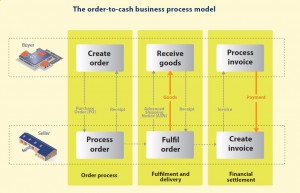


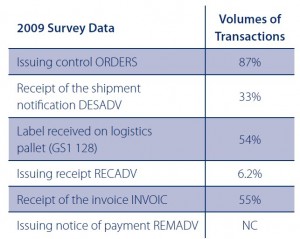

 صاحب امتياز
صاحب امتياز